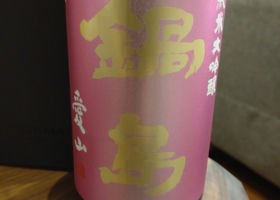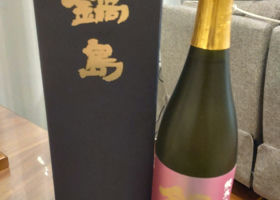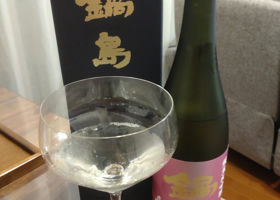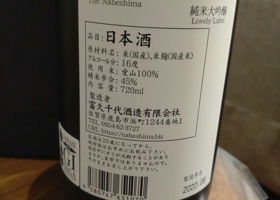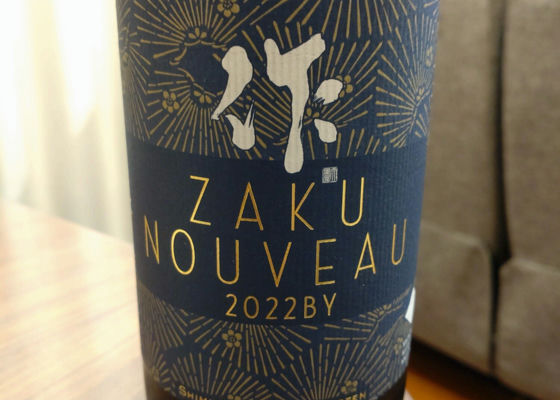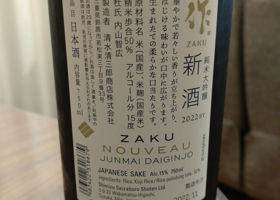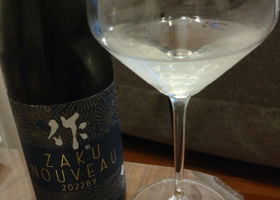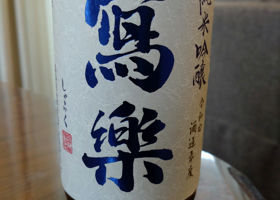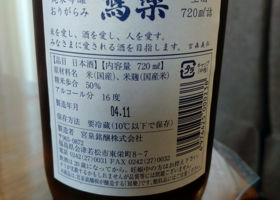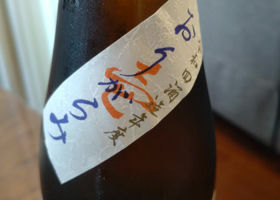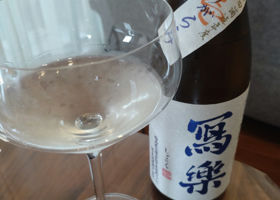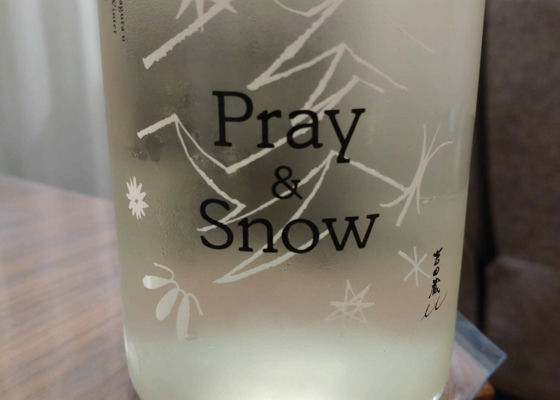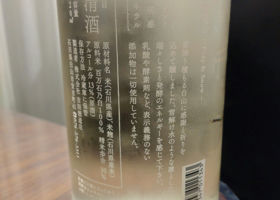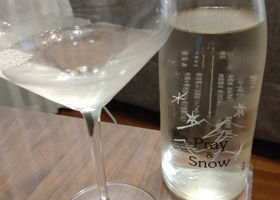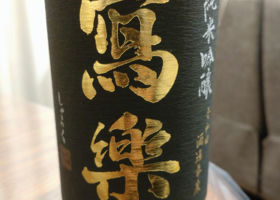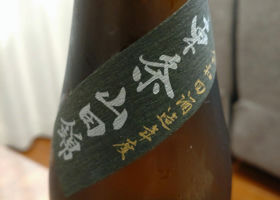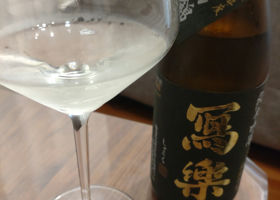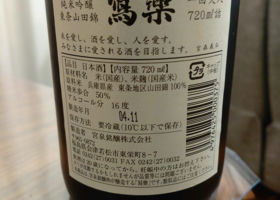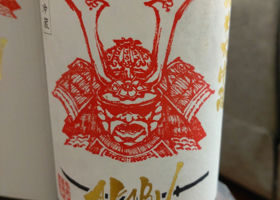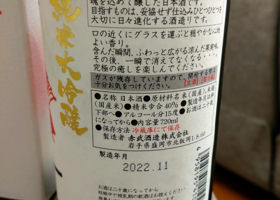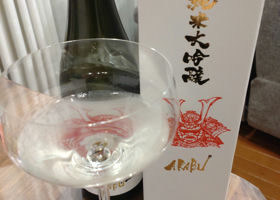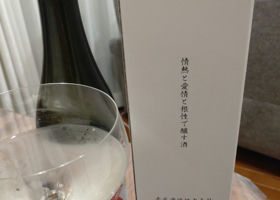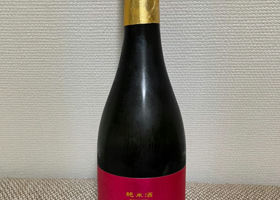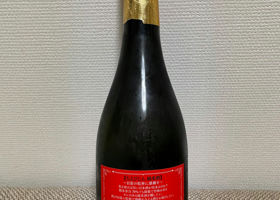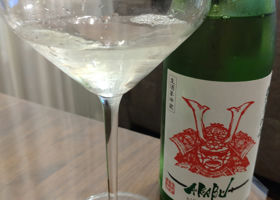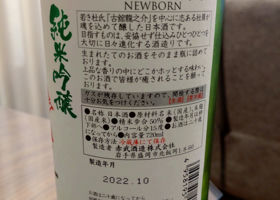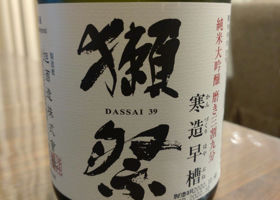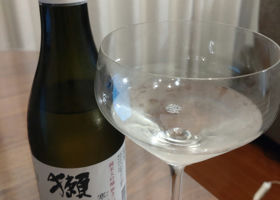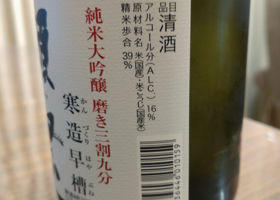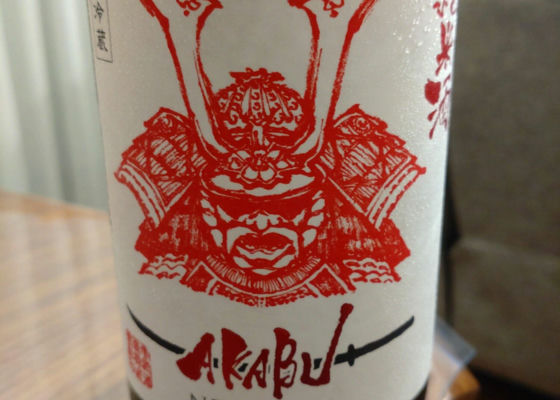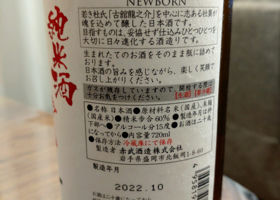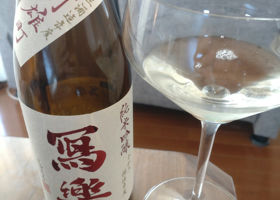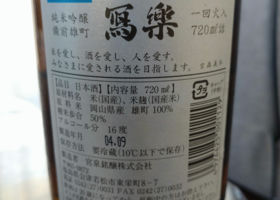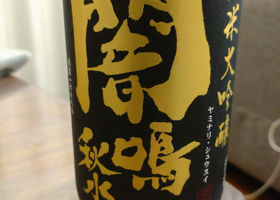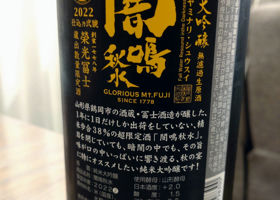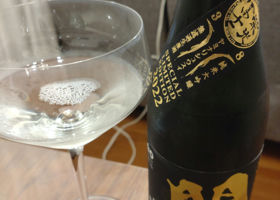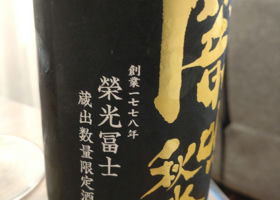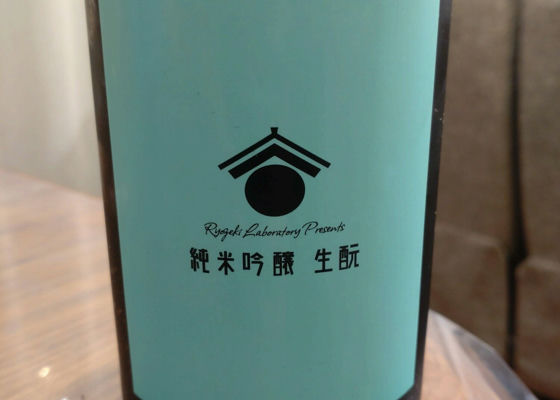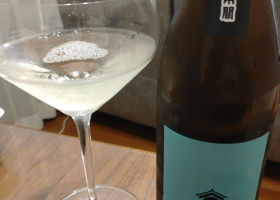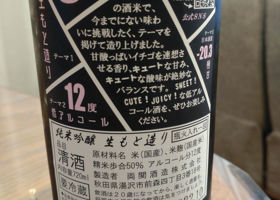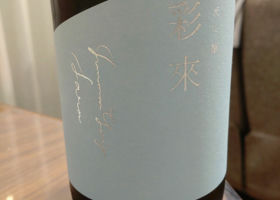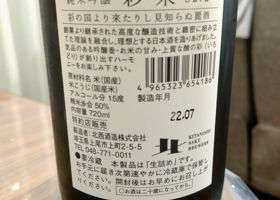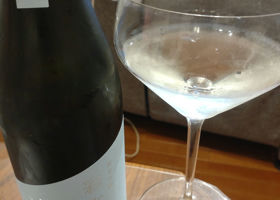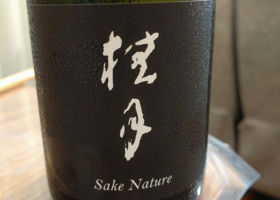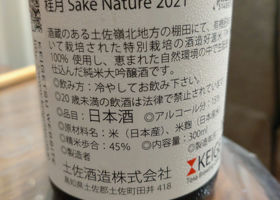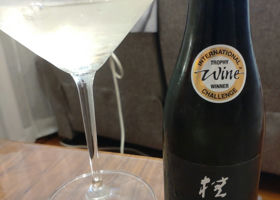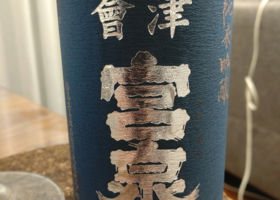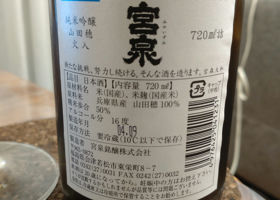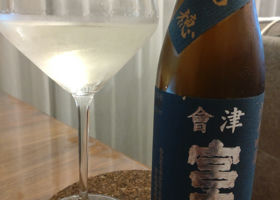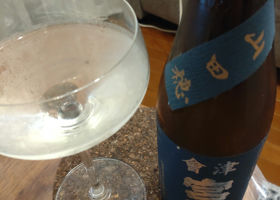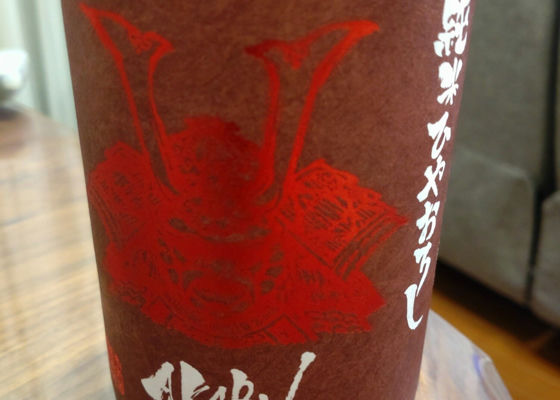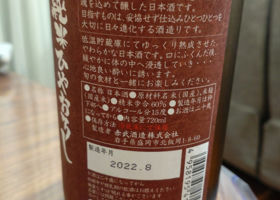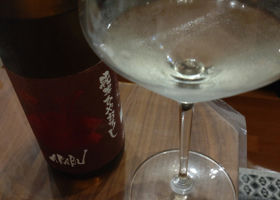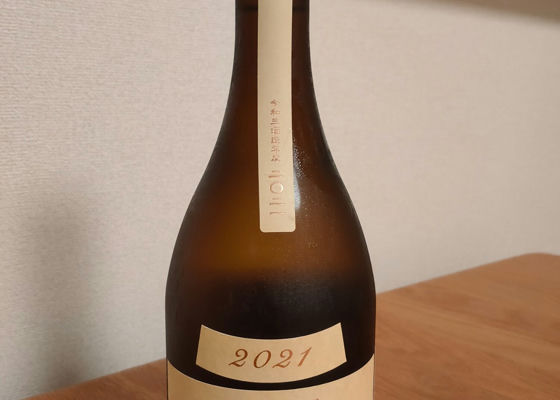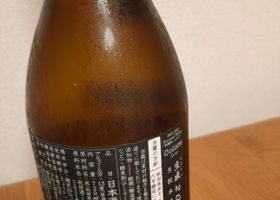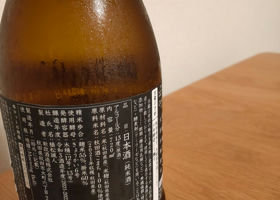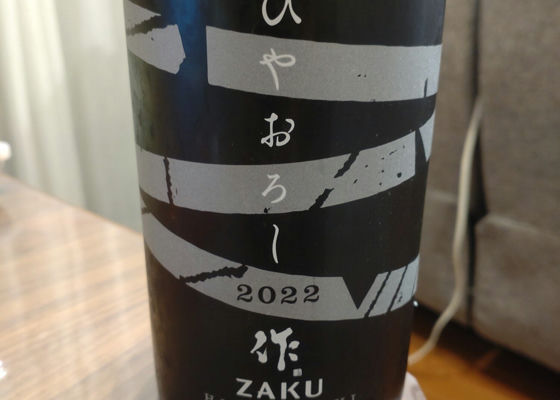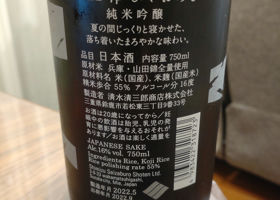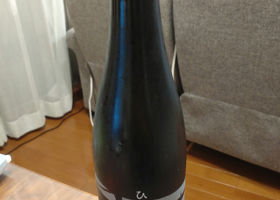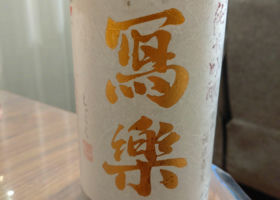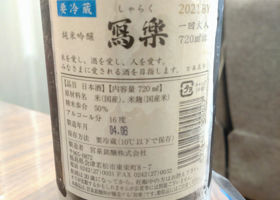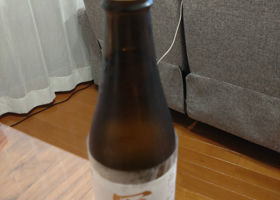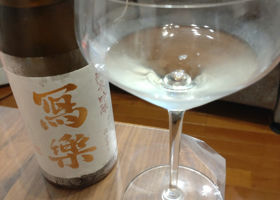Timeline
KumakichiWhile browsing the lineup at my favorite liquor store, I suddenly noticed that in the refrigerator dedicated to gift boxes, there was an Aizan Junmai Daiginjo from Nabeshima tucked away!
A Junmai Daiginjo made by that Aizan of Nabeshima!
How could it not be delicious? I know the answer for sure, but I wanted to taste this one at any cost, so I immediately bought it and opened the bottle!
The production date is August 2022, so even though it has been laid down for about 4 months, it still has a nice, fresh feeling at the time of opening!
However, after taking a sip, the harmony of sweetness, deliciousness, and acidity in harmony with the deliciousness of Aizan is superb!
Out of the nearly 300 bottles I drank this year, this was definitely one of my BEST 5 favorites! It comes in a box, and at 3,000 yen, it's not cheap, but it's a bottle that I'm fully satisfied with!
Rice polishing ratio: 45% (100% Aizan)
Alcohol content: 16%. KumakichiA bottle of Junmai Daiginjo, a new sake from "Saku", which was especially highly anticipated among the rush of new sake.
I had made up my mind to stock up on it for the New Year's holidays, but I couldn't resist...
The taste was fresh and new sake-like, while retaining the gorgeous & mellow flavor of Saku!
It was a bottle that I could enjoy sipping on without a side dish.
Rice polishing ratio: 50%.
Alcohol content: 15%. KumakichiI had a bottle last year and it was so good that I repeated it several times.
This is the first in a series of freshly pressed, freshly milled, freshly squeezed, freshly brewed sake from 寫樂.
It has the mellow flavor that is typical of 寫樂, but the freshness of the new sake makes it hard to stop drinking!
I challenge you to see how many times you can repeat this year!
Rice polishing ratio: 50% (100% Gohyakumangoku rice)
Alcohol content: 16%. KumakichiOne recommendation from a person I met on SNS.
A bottle of Yoshidagurau, a private brand of Yoshida Shuzo, famous for Tedorigawa, for a limited time only
A bottle brewed with 30% polished Hyakumangoku No Shiro produced in Ishikawa Prefecture, a well-balanced bottle!
You can enjoy the clear and refreshing sweetness, but when you swallow it, the balance between the pleasant acidity and the gradually expanding umami is superb!
It was a bit pricey, but it is a bottle that I will surely repeat!
Rice polishing ratio: 30% (100% Hyakumangoku No Shiro)
Alcohol content: 13%. KumakichiYamada Nishiki series by 寫樂
This pattern, which must be delicious, makes me want to buy a bottle on impulse every time!
This year we decided to go with Tojo Yamadanishiki Junmai Ginjo, single exposure.
It has a fresh yet gorgeous aroma and a rich sweetness, but it also has a beautifully clean finish, which is typical of 寫樂!
Rice polishing ratio: 50%.
Alcohol content: 16%.
KumakichiLast month we had the NEWBORN Junmai -> NEWBORN Junmai Ginjo from Akabu and it was so good that we got the Junmai Daiginjo Namaishu, which is a one rank up from the previous version!
The Junmai Daiginjo is about 2,600 yen, but it comes in a box, which makes it look all the more luxurious, but I have to take my hat off to the taste...
The Junmai-Daiginjo was delicious enough, but the more concentrated sweetness and umami was so good that I was enchanted!
Rice polishing ratio: 40
Alcohol content: 15 としちゃんMatsuzaki's
First visit to Urawa branch
A variety of attractive sakes
I was attracted by the label
I was attracted by the label
I chose this one.
Sweetness comes first
After a slight bitterness
After a slight bitterness, there is a lingering alcohol taste.
It may be a little too sweet.
but the taste of this junmai sake is
It is wonderful!
It was also good value for money. 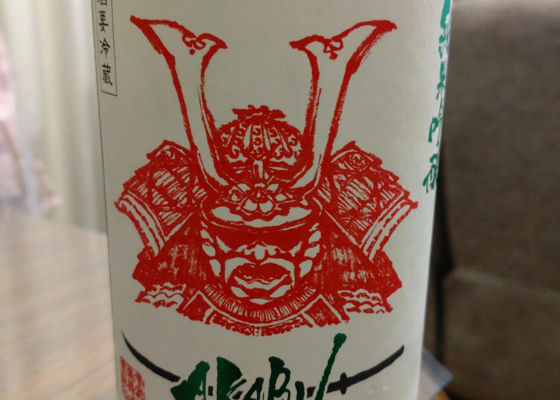
KumakichiToday is 11/11 Standing is Drinking Day, and just when I was planning to drink standing up, I had to work overtime and couldn't drink standing up, so I drank at home,...
I opened a bottle of Akabu NEWBORN Junmai Ginjo at the counter kitchen to enjoy the standing drinking mood!
Last week we had a bottle of NEWBORN junmai sake, and this time it was a junmai ginjo, which tasted even better than the previous one!
The fresh, sweet and delicious taste of nama-zake is as fruity as a pear!
I loved its gorgeous aroma and refreshing taste!
Rice polishing ratio: 50%.
Alcohol content: 15%. 香穏kanonGood evening, Kumakichi!
I see today is also the day for standing up and having a drink!
Zoro day is indeed full of anniversaries 😂👍
I don't have much experience with standing drinking.
I've never had a chance to drink standing up, so I admire you for being a drinker 🥰. KumakichiGood evening, Mr. Kashu kanon! My favorite standing bar said they would serve rare sake today, but I couldn't go...............tears!
I like to sit down and relax, but I also like to drink sake while standing up because it has its own taste! KumakichiOtter's Kanzukuri Hayabune freshly squeezed raw, which you will want to drink at this time of the year.
Most of the Otters on the market are fire-aged and have a uniform taste, but I can't help but want to drink the Otter Nama-shu, which is only available for a limited time and in limited quantities!
And when it's made with a 30%-90% polishing ratio, it's bound to be good!
When you open the bottle, you will hear the pleasant sound of the bottle being opened.
When you take a sip, it has a refreshing fruity taste like green apples and a freshness that stimulates your taste buds!
Rice polishing ratio: 39
Alcohol content: 16%. KumakichiAfter enduring hard work, we opened a bottle of Junmai NEWBORN by Akabu Shuzo.
It was my first time to drink Akabu NEWBORN, so I took my time and found it to be a light but enjoyable bottle!
NEWBORN has a fresh, petit-swirling mouthfeel due to the fact that it is a draft sake. It has a slightly bitter and complex flavor that can be enjoyed as a mid-meal drink or on its own.
At only 1,540 yen for this one, I'd make it my resident sake!
Rice polishing ratio: 60
Alcohol content: 15%. ハリーGood morning, kumakichi😊.
It's a new sake from Akabu - is it available at Matsuzaki, I
I have to go there😅 KumakichiHello Harry Sakeboy! Last week there was a new junmai shinshu and it looks like there will be a new junmai ginjo shinshu this week. Urawa will be late getting it, but it may be available at other stores. It's going to be crowded since the annual event starts today. KumakichiNovember is the season when you can enjoy more and more delicious food and drinks as you feel the arrival of winter!
We opened a bottle of Bizen Omachi by 寫樂, a sake that I personally believe never fails among food sake!
The aroma is gorgeous and fruity from the first sip, and the sweetness and deliciousness is like biting into a Shine Muscat!
What's that? I thought I opened it a while ago, but it's almost gone... The price has skyrocketed recently, but it's a delicious bottle with no disappointments.
Rice polishing ratio: 50% (100% Omachi produced in Okayama Prefecture)
Alcohol content: 16%. KumakichiEiko Fuji's very popular annual limited edition sake "YAMINARI SHUSUI" available again this year
Since I had a sore throat last weekend, I decided to make my favorite sake the first bottle I would drink after my abstinence from alcohol...
So I chose this bottle.
This is a Junmai Daiginjo brewed with 38% Dewanosato, and the price is only 1980 yen for a four-pack!
The taste is as exquisite as one would expect, with a gorgeous aroma from the top, and a beautiful pear-like, clean, sweet flavor in the first sip! From there, you can enjoy the lingering flavor that gradually spreads from there.
Rice polishing ratio: 38% (using Dewanosato)
Alcohol percentage: 16.9%. KumakichiWe found the Ryoseki Labo, a new attempt created by Ryoseki Sake Brewery, from whom we always get Hanayu!
We were served Ryoseki Labo sake, made with local sake rice Miso Nishiki, with three themes: "Nama Moto Sake", "Extremely Sweet", and "Low Alcohol Sake"!
I was prepared to open the bottle because of the extremely sweet taste, but the sweetness was less than I expected due to the Misato Nishiki rice.
It was a bottle with a refreshing acidity from which the deliciousness gradually spread!
Rice polishing ratio: 50% (100% Misato Nishiki)
Alcohol content: 12 KumakichiLong time no see, Saira Junmai Ginjyo.
Recently popular sweet and tasty sake brewed by Kitanishi Shuzo in Ageo City, Saitama Prefecture.
The bottle design is very stylish!
The bottle is fire-aged, so it doesn't have the same freshness, but the sweet, muscat-like ginjo aroma is very exciting!
The sweetness of the rice flavor spreads slowly like cotton candy, but it is cut off by the acidity, making it easy to drink without any harshness!
It is a delicious bottle after all!
Rice polishing ratio: undisclosed
Alcohol content: 15%. KumakichiA bottle of Tosa Shuzo from Kochi Prefecture that I have been curious about for a long time.
Kaygetsu Junmai Daiginjo Sake Nature 2021 was sold in mini bottles, so I bought it!
This sake is made from "Gin-no-Yume" rice grown in the Tosa Reinokita region, polished to 45%, and brewed using the traditional sake brewing method.
The taste was a bottle with a refreshing sweetness and a unique sourness that cut through nicely.
I should have bought a four-pack bottle instead of a mini-bottle.
Rice polishing ratio: 45% (100% Gin no Yume)
Alcohol content: 15 KumakichiMiyazumi Junmai Ginjo Yamadaho Hi-iri, which was opened last night and disappeared in an instant.
I usually like 寫樂 and have had many limited edition and regular sakes, but I had never had much Miyazumi!
However, I used to buy the Yamadaho from Isshaku Suisei on repeat because it was so good, so I decided to buy the Miyazumi from the same rice.
This one is hi-iru, but it starts with a faint fizzing sound when it opens, and its fresh white grape aroma and piquancy are delicious!
When you take a sip, you can't get enough of the crisp sweetness, grapefruit-like acidity, and bitter aftertaste!
I found myself finishing the entire bottle in less than two hours (sweat).
Rice polishing ratio: 50% (100% Yamadaho from Hyogo Prefecture)
Alcohol content: 16%. KumakichiToast with Akabu Junmai Hiyoroshi on the far shore
It was a happy day when my father who collapsed half a year ago was released from the hospital today after a successful recovery, so we opened a bottle of Akabu, a sake from Iwate Prefecture, where my father was born.
Many of Akabu's regular and limited edition sake are delicious, so this was the first time for me to try their hiyaoroshi sake, but the taste was outstanding!
The aroma was slightly melon-like and sweet from the first sip.
Is this Junmai? It tasted so beautiful!
Rice polishing ratio: 60
Alcohol content: 15 こいちあんIt was a very strange sake.
I would like to enjoy another Shinsei again, but it is not easy to buy...
My wife's evaluation: 0 (wine taste? I can't buy it very often...)
This is also known as "Ecru".
This is the bottom line using Akita-born sake rice "Sake-komachi". Like Lapis, it is polished using "flat polished rice". It has a clean taste that is reminiscent of melted snow in cold regions, which is unique to Sakekomachi. As an entry-level model, we hope many people will enjoy this sake.
Sake Komachi
Year of birth [registered year]: 2004 (Heisei 16)
Place of birth [registered prefecture]: Akita Prefecture
Average yield: About 8 bales/wheel
Main cultivation area in Shinsei: Kawabe Wada district, Akita City KumakichiTonight we will open a bottle of Saku Junmai Ginjo Hiyayogoshi while watching the Mid-Autumn Moon!
On the first day, I could taste the fresh sweetness of white grapes and a fruity flavor despite being fire-aged, but from the second day, I felt a mild sweetness and sharpness.
Now that the hiyaoroshi season has been lifted, I would like to enjoy a bottle of each brewery's pride and joy to the fullest!
Rice polishing ratio: 55% (100% Yamadanishiki from Hyogo Prefecture)
Alcohol content: 16%. KumakichiThis year, we have had a lot of sake, but we realized that we had never tried Collage's Junmai Ginjo, and we bought it for the first time.
Junmai Ginjo Collage
I have had a number of limited edition sake such as Sake Mirai O 2, Banshu Yamadanishiki and Aizan, but I have only had Junmai as a regular sake.
At first, when served cold, the aroma and the sweetness were almost suppressed and the taste was crisp and dry.
As it gradually warmed up at room temperature, it started to bloom...
The aroma was sweet like white grapes and I could feel the sweetness on the tip of my tongue, but I could also enjoy the umami and bitter aftertaste.
This was a dish that could be enjoyed both during the meal and on its own.
Rice polishing ratio: 50%.
Alcohol content: 16%. RecommendedContentsSectionView.title
